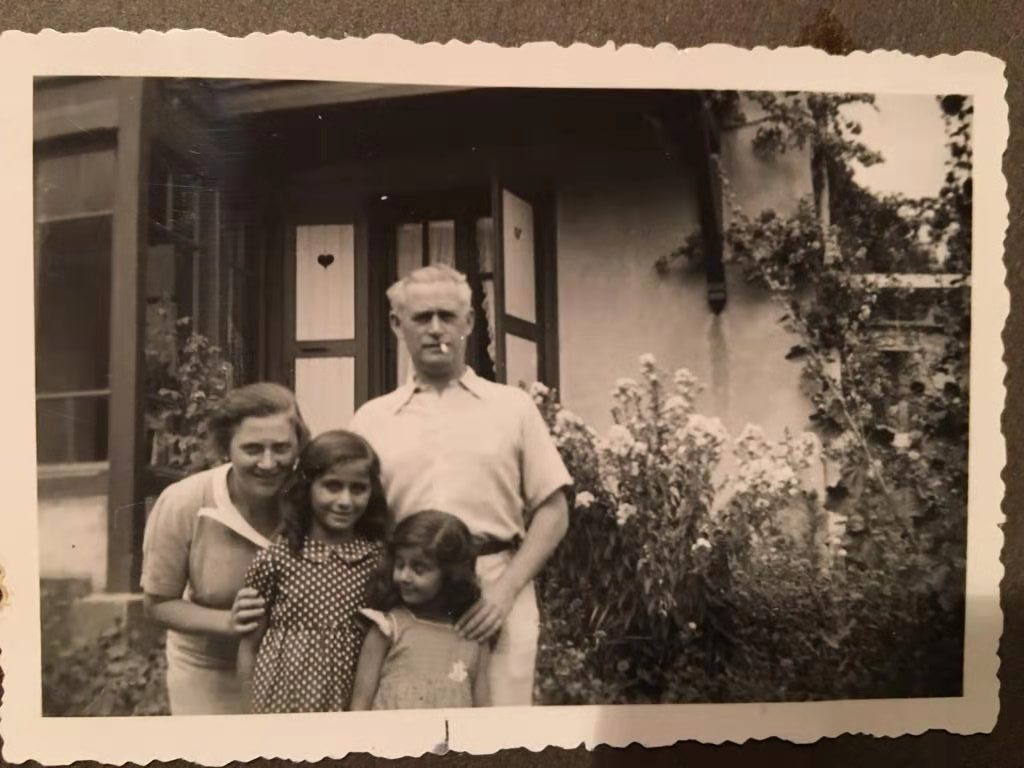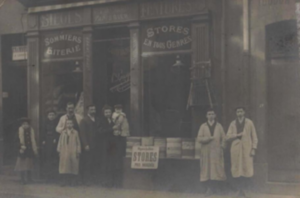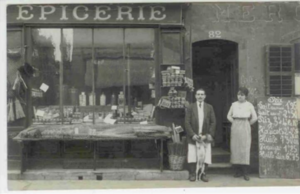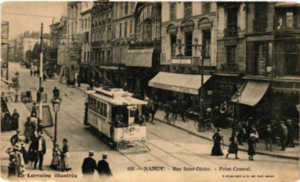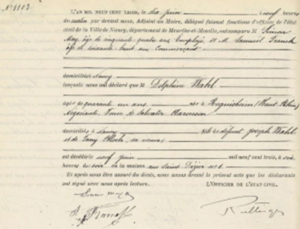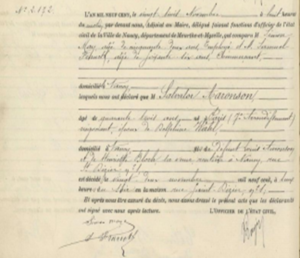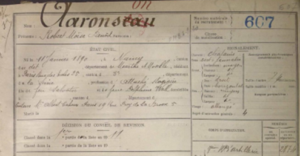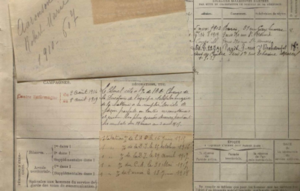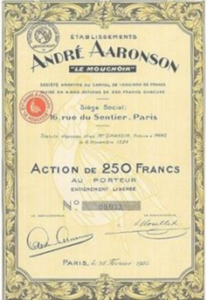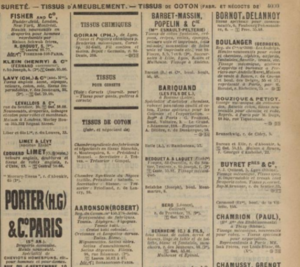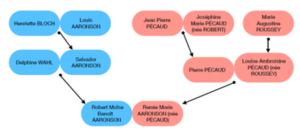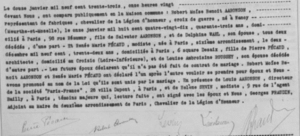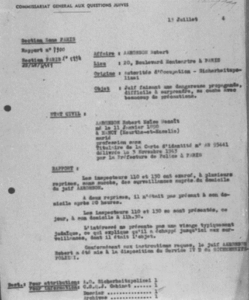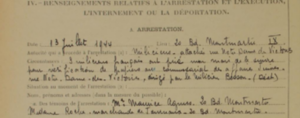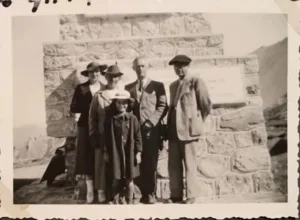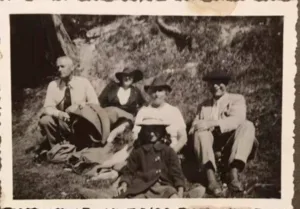Robert AARONSON
A photo of Robert with his wife and two nieces, taken in 1938.
Source: Family archives
Biography of Robert Moïse Benoît Aaronson
January 11, 1890 – August 3, 1944
As part of our citizenship curriculum, we, a class of 10th grade students at the Charles de Gaulle International High School in Dijon, in the Côte-d’Or department of France, researched and wrote this biography of Robert Aaronson. A hero of the First World War, he was arrested and deported on Convoy 77 on July 31, 1944.
Born into a large family
Robert Moïse Benoît Aaronson was born on January 11, 1890 in the Meurthe-et-Moselle department of France. He was the youngest child of a large family. His parents married in Paris in 1883. His father, Salvator Aaronson, a wholesale fabric merchant, was born on March 1, 1857 in the 4th district of Paris, where he continued to live until he got married. His family had come to France from Latvia (which at the time was occupied by Russia) and his father, Louis Aaronson, who died in August 1884 at the age of 57, was a cap or hat maker in the Marais district of Paris. Records of his presence in Paris date back to June 1856, when he married Henriette Bloch, who was also born in Paris in 1837. On July 24, 1877, Louis Aaronson was granted residency in France together with full legal rights for as long as he lived there (source: Records of people from Alsace and Lorraine who had taken French nationality. Town hall of the 4th district of Paris). The family’s roots in France therefore went back a long way.
Robert’s mother, Delphine Wahl, was born in Réguisheim, in the Bas-Rhin department of France, in 1861, but at the time of her marriage to Salvator Aaronson, she was living in Paris with her mother, Fanny Bloch Wahl, a milliner in the Marais district, her father having already died by then.
We do not know when or why the couple left Paris and moved to Nancy, but it was shortly after their marriage on November 29, 1883. They had had family there, including a cousin, Nathan Weill, who worked as a leather merchant or hatter, and was a witness when Louis and Berthe’s births were registered.
Delphine was a homemaker and had five children: Louis ( named after Salvator’s father, who had recently died), born on October 14, 1884, but sadly died at just a few weeks old on November 12, 1884; Berthe, born on February 2, 1886; Louis, born on December 14, 1886; and André Samuel, born on February 20, 1888. All the children were given French first names and all were born in the family home at 46, rue des Ponts in Nancy.
Rue des Ponts was one of Nancy’s oldest streets, located in the Saint-Sébastien district. It was a very busy shopping area. Their house no longer exists, as the district was modernized in the 1960s and a shopping mall built on the site. However, we found some very early photos of the Rue des Ponts. We can just imagine how well Robert and his family knew these stores, and probably even shopped in some of them.
Photo of Auguste Poinsignon upholsterers at 42 rue des Ponts in the late 19th century
A grocery store at 82, rue des Ponts
The market in the Saint- Sébastien district
The family then moved to 1, rue Saint Dizier in the same neighborhood. This was also a very busy street, with a wide range of stores, along which the tramway ran.
Robert was a good student, and while he was in 9th grade in high school in 1897, he was nominated for nine awards, as reported in the Est Républicain newspaper of August 9 of that year.
Postcard of rue Saint-Dizier in Nancy in the early 20th century
Robert, his sister and two brothers were orphaned at an early age. Their father died on November 26, 1900, in Nancy, but was buried in a vault in the Montparnasse cemetery in 1902, and their mother died in 1903. Guardians were appointed to oversee the siblings’ education. The sale of Salvator’s business to the Jacob brothers, around 1904, appears to have been difficult.
Salvatore Aaronson’s death certificate (1900)
Delphine Aaronson’s death certificate (1903)
Robert was entrusted to Albert Cahen, a well-to-do cousin and father of the professor and linguist Maurice Cahen, who was married to his paternal aunt, Berthe. When he did his military service in the French artillery in 1911, he was a “trainee attaché” and lived at 25 rue des Ecoles in the 5th district of Paris with his grandmother Wahl, who was his brother André’s guardian. In 1912, he was living at 19, rue Guy de la Brosse, in the 5th district of Paris, near the Sorbonne university, with the Cahen family. At least, this is how his niece Henriette Cahen, who was still alive in 2020, remembers that time. He remained in Paris until he was arrested in 1944, during which time he lived in a number of different districts, including the 8th and 18th, where he was living in 1931, and the 1st, where he was living in 1939. During his military service, he was temporarily discharged due to chronic bronchitis. His heath, already fragile, was made worse by the war.
His military service record reveals a great deal about his physique and his educational background. He was fairly tall for his time, at about 5’8″. The average height for men at the time was less than 5’6″. His eyes were green and his hair brown. His face was long, with a straight, medium-sized nose. His educational standard was good, at 4 out of 5, which means he had a junior high school diploma. This was the qualification before the French baccalaureate, which is the equivalent of graduating from high school.
Extract from Robert Aaronson’s military service record
Robert Aaronson, a World War 1 hero
Called up on August 3, 1914, Robert joined the 12th artillery regiment based at Saint-Dié, in the Vosges mountains. He fought in the Battle of the Marne in the east of France, and in then 1915 in the Notre-Dame-de-Lorette area in the north of France. He received a commendation in the Army Order:
“Responsible for leading the company telephone team, he fulfilled his role perfectly in all situations and performed a great service during the fighting from March 28 to April 5, 1915.”
He received four more commendations before the war was over. He was wounded twice.
Extract from Robert Aaronson’s military service record
In 1918, Robert was seconded to the Aeronautic Corps and joined the F 60 squadron of the 2nd aviation unit. He was demobilized on August 8, 1919. Robert Aaronson thus fought throughout the entire military campaign from August 1914 onwards, although was temporarily invalided out due to chronic bronchitis.
In recognition of his outstanding service, he was awarded the French War Cross and made a Knight of the Legion of Honor. In June 1938, he was deemed to be unfit for compulsory service, and served for just four days. He was struck off the military register on March 29, 1939. However, in May 1939 it was decided that, in the event of conflict, he would be assigned to the French Air Ministry.
Robert Aaronson’s military achievements
Archives israélites de France (French Jewish archives) (1919)
His two brothers were also called up. Louis Aaronson, who was a storekeeper at the time, served in the infantry. André Samuel Aaronson, who made handkerchiefs in the Sentier district of Paris, fought in the artillery. He was also commended by his regiment for having ” maintained his gun until it was put out of action by the explosion of a large-caliber shell “. He was awarded the French War Cross.
After World War I, work life and marriage
After returning to civilian life, Robert worked as a sales representative for several companies, as shown in an extract from the 1928 trade register. That same year, he was a manager of Société Parisienne des produits mondiaux (Paris Global Products Company), founded by a Mr. Chantrel..
The Seine trade register (1928)
In 1933, he married Renée Marie Pécaud, a Parisian milliner born on December 2, 1900 in the 6th district of Paris. She was about ten years his junior. Her parents were Pierre Pécaud, an architect born in Saint Nazaire in the Loire Inférieure department France, on May 8, 1879, and Louise Ambroisine Roussey, a dressmaker. Might he have met her as he toured around for work. He sold fabrics, and his wife’s mother was a milliner.
A simplified version of Robert Aaronson and Renée Pécaud’s family tree.
Produced by the 10th grade students
Robert Aaronson and Renée Pécaud’s marriage certificate
Robert and his wife lived at 20, boulevard Montmartre in Paris.
The German Occupation and Robert’s arrest
Based on archived records, we have been able to partially reconstruct Robert’s life during the German Occupation. He remained in the capital with his wife, and made no attempt to escape to the unoccupied zone. As a French citizen, a hero of the Great War, married to an “Aryan” woman, he could hardly imagine that he was in any danger. Nevertheless, he fell victim to the anti-Semitic laws. For example, he was no longer allowed to work as a salesman. He was forbidden to leave his home without permission, and had to abide by the curfew. He led a life that could be described as semi-clandestine, keeping out of sight to avoid being arrested.
Nevertheless, at around midday on July 13, 1944, he was arrested in his home. He was held for a few hours before being transferred to the headquarters of the Sipo-SD, the German security police, on rue des Saussaies. He was taken to the Drancy internment camp on July 15, 1944. One can only imagine how his wife tried hard to have him released, highlighting her husband’s patriotism, his awards and his commitment to France. It was precisely this patriotism that led to him being discovered by the occupying authorities.
Arrest report for Robert Aaronson (July 13, 1944)
Center for Contemporary Jewish Documentation
The official report drawn up by the 10th district of Paris branch of the Commissariat Général aux Questions Juives (General Commission for Jewish Affairs), record the reasons for Robert’s arrest as: “Jew, dangerous propagandist, difficult to catch by surprise; careful to keep himself hidden”. He had been under surveillance for several days, or perhaps even weeks, and it was the Sipo-SD who had tasked the French authorities with the task of arresting him. Some French police officers, or rather militiamen, as Robert Aaronson’s wife pointed out, noticed that he “was not at his home after 8 p.m.”. According to a German decree, which came into force on February 7, 1942, Jews were forbidden to be outside homes between the hours of 8 p.m. and 6 a.m. Robert was therefore already in breach of the law at the time he was arrested.
One particular detail caught our attention. The investigators noted that Robert Aaronson “does not have a typically Jewish face”, and that this would have enabled him “to escape the surveillance he was under”. This point about his facial features was a racist notion rooted in anti-Semitic prejudice. According to the Nazis, Jews had curved noses, crooked fingers, protruding eyes, dirty, clenched teeth, protruding ears and long beards. n France, during the Occupation, these prejudiced beliefs were picked up by George Montandon, a Swiss-born French anthropologist and professor at the Paris School of Anthropology, who espoused what he called “scientific” racism. He claimed to be able to determine the ethnic origins of the people he examined based on their physical characteristics. Montandon carried out “racial checks” and “anthropometric examinations”. He also issued “certificates of non-membership of the Jewish race”. This was pure pseudo-science, yet it was taken very seriously.
Some people were aware of this, such as the two police officers or militiamen who arrested Robert Aaronson. We spotted the Nazi’s double standards here. After all, it was they who made Jews wear a yellow star in order to be able to identify them in public, thus suggesting that Jews could not in fact be identified by their physical appearance.
There are two archived reports on Robert’s arrest. The first, above, mentions two officers referred to only by their numbers 100 and 130, to ensure that they could not be identified. The second is a post-war account by Renée Pécaud Aaronson, in which she describes three militiamen under the command of a man named Besson from the Déat militia. They took Robert Aaronson away on the pretext of an identity check. The police report states that after having interrogated him at the Commission for Jewish Affairs offices in Rue Notre-Dames-des-Victoires, they handed him over to the Germans, or to be exact, to the German Security Police, which included Section IV, otherwise known as the Gestapo.
Two days later, he was transferred to Drancy camp. We know nothing of what happened during his brief stay in rue des Saussaies, but no one who was interrogated there emerged unscathed. We can safely assume therefore, that like everyone else who fell into the hands of the Gestapo, Robert Aaronson was beaten, if not tortured.
When he arrived at Drancy, he was assigned the serial number 25191. According to his search record, he handed over 26,777 francs and six five-thousand-franc treasury bonds to the camp authorities. This shows that when he was arrested, he had no idea what was going to happen to him!
Application for “political deportee” status (1955)
His wife mentioned that there were two witnesses to her husband’s arrest, both of whom lived in the same building. This was a common situation, since deported people’s families had to prove that they had been deported for political reasons (on grounds of their “race”) rather than for offences under common law.
On July 28, Robert Aaronson was able to send news to his wife for the very last time. Although as the “spouse of an Aryan” he should have been protected, especially at a time when the Allies were advancing towards Paris, Robert was denied any such protection. Might his night-time outings have been related to anti-German activities? His wife said nothing about this, and did not apply to have him recognized as having been a Deported Resistance Fighter. She stated that the motive for his arrest was “Israelite”, meaning “Jewish”.
Robert was deported on July 31, 1944, a few weeks before the liberation of Paris, an event in which he would certainly have been involved on account of his past military service. According to his widow, Renée Aaronson, he was “a reserve officer who was appointed an honorary officer on April 14, 1914 following the removal of a kidney. Could take up arms to liberate Paris”. No doubt they had both dreamed that day would come!
Application for “political deportee” status (1955)
Victims of Contemporary Conflicts Archives Division, ref. 21 P 416 299
After the war, Renée Aaronson attempted to find out what had happened to her husband. He had died in Auschwitz. She succeeded in having him recognized as having been a political deportee in 1957. The words “Mort pour la France” (Died for France) were added to his death certificate on April 13, 1965, in the town hall of the 9th district of Paris. Renée, in failing health, was cared for by Henriette Cahen, one of Robert’s nieces. She is buried in Dourdan, in the Essonne department of France, and Robert Aaronson’s name is inscribed on her headstone, together with her own.
Notification of the decision to issue a political deportee card (1957)
Victims of Contemporary Conflicts Archives Division, ref. 21 P 416 299
Photos of Robert and his family in 1938,
Cahen family archives
Sources
- French Ministry of Defense Historical Service
– Victims of Contemporary Conflicts Archives Division), file refs. 21 P 416 299 and 21 P 244 123
- Shoah Memorial in Paris
– Drancy records, search logbook and transfer book
- Paris Municipal archives
– Robert Moïse Benoît Aaronson’s service record
- Nancy Municipal archives
– Birth and death certificates of Robert Aaronson’s family members


 Français
Français Polski
Polski